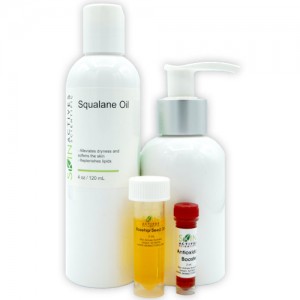Plants and the chemicals they make. Squalane vs. Squalene, what is it derived from?
Squalane Oil, the serum base in the new Oil Serum For Beginners Kit, is extracted from olive fruit, not from shark liver. This light oil is full of beneficial actives especially suited for the skin; among them are oleuropein, hydroxytyrosol, caffeic acid, catechin, and rutin. Loss of skin lipids results in an increased water loss and increased penetration of harmful compounds, especially for people living in big cities. Continuous use of squalane oil should alleviate skin dryness.

Why Squalane?
Lipids are an important part of our skin chemistry, they are necessary for the skin to do its job of limiting water loss from the body. Lipids also work by blocking pain signals. It is my hypothesis that the explosion in people with “sensitive skin” has to do with the obsession (planted in our brains by the skin care industry) that our skin has to be ultra clean. We are forgetting that the primary function of the skin is to prevent water loss and the entrance of noxious substances and microorganisms into our body.
Squalane versus Squalene
You may remember from high school that hydrocarbons (made only of C and H atoms, no N or O here) have a special nomenclature. Names ending in “ane” are saturated: each carbon has its 4 bonds occupied. Names ending in “ene” mean that there is an unsaturated carbon there, with a double bond somewhere.
Squalene, with 6 double bonds, is a natural chemical present in many plants and animals, including humans.
Squalene is also a triterpene, a class of chemical compounds composed of three terpene units with the molecular formula C30H48. Animals, plants and fungi all create triterpenes, with the most important example being squalene as it forms the basis of almost all steroids.
Squalene sounds like a potentially good emollient for skin care but, because of its chemical structure, it is not stable enough. For this reason, natural squalene is first reduced to squalane before being added to creams and serums.
What do you have in common with a shark?
Squalene. There is no reason to source squalane or squalene from sharks. At an estimated annual global cosmetic use close to 2,000 tons, this would mean millions of shark livers would be required to satisfy global demand. Because this hydrocarbon is present in practically all plants and animals, it makes a lot more sense to extract it from plant oils. This is why our Squalane Oil is sourced from olives; it is just as good for the skin and much better for the environment.
